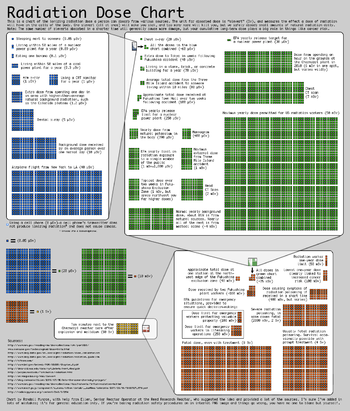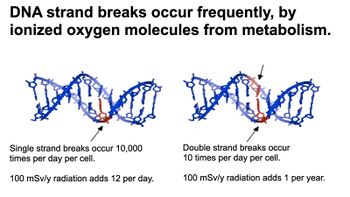Radiation Hazards: Difference between revisions
Jess Brewer (talk | contribs) mNo edit summary |
Jess Brewer (talk | contribs) No edit summary |
||
| Line 8: | Line 8: | ||
Figure 1 compares a range of radiation exposures, from the dose received from sleeping next to another human for a night (0.05 <math>\mu</math>Sv) to the usually fatal dose of 4 Sv, a hundred million times greater. '''''Warning''''': such comparisons can be misleading unless one understands that some are "delivered all at once" and others are "accumulative" over times up to a year. There is great controversy over the latter, since DNA usually "heals" strand-breaks due to free radicals produced by ionizing radiation (see Fig. 2) within hours or days,<ref>[https://www.ncbi.nlm.nih.gov/pmc/articles/PMC4060780/ "Effects of Ionizing Radiation on Biological Molecules—Mechanisms of Damage and Emerging Methods of Detection", Julie A. Reisz, Nidhi Bansal, Jiang Qian, Weiling Zhao, and Cristina M. Furdui] doi: 10.1089/ars.2013.5489</ref> suggesting that doses may '''not''' "accumulate" over longer periods. | Figure 1 compares a range of radiation exposures, from the dose received from sleeping next to another human for a night (0.05 <math>\mu</math>Sv) to the usually fatal dose of 4 Sv, a hundred million times greater. '''''Warning''''': such comparisons can be misleading unless one understands that some are "delivered all at once" and others are "accumulative" over times up to a year. There is great controversy over the latter, since DNA usually "heals" strand-breaks due to free radicals produced by ionizing radiation (see Fig. 2) within hours or days,<ref>[https://www.ncbi.nlm.nih.gov/pmc/articles/PMC4060780/ "Effects of Ionizing Radiation on Biological Molecules—Mechanisms of Damage and Emerging Methods of Detection", Julie A. Reisz, Nidhi Bansal, Jiang Qian, Weiling Zhao, and Cristina M. Furdui] doi: 10.1089/ars.2013.5489</ref> suggesting that doses may '''not''' "accumulate" over longer periods. | ||
==Notes and References | =Mortality= | ||
Paraphrased from memory: Front page of special HEALTH edition of the LA Free Press (around 1970): | |||
''"No matter how much money you have, how good your health care provider or how healthy your diet and life style, | |||
'''you''', ''personally'', are going to '''die'''."'' | |||
(I don't really want to believe this any more than you do, but I have to confess that the evidence for it is persuasive.) | |||
Either way, it makes an excellent starting point for any discussion of ''hazards''. We cannot (for now) avoid dying, but we can exercise some influence over ''when'' we will die and ''from what causes''. We also (for now) get to choose how much of our enjoyment of life and liberty we sacrifice to this effort. | |||
=What is "Radiation"?= | |||
* '''Electromagnetic Waves''': | |||
- AM Radio, FM Radio, Shortwave Radio, TV, Cell Phones, WiFi, Microwave, Visible Light — all harmless at low intensity. | |||
- Near Ultraviolet (UV) — beneficial at low doses (Vitamin D) | |||
- Far UV, X-rays, Gamma-rays — damaging at all levels | |||
* '''Fast Massive Particles''': | |||
- Electrons (<math>\beta</math>-rays) | |||
- Protons & Neutrons | |||
- <math>\alpha</math>-rays (<SUP>4</SUP>He nuclei) | |||
- Heavy Ion Beams | |||
* '''What does the Damage?''' | |||
- Enough intensity of ''anything'' will "cook" you. | |||
- ''Highly reactive free radicals'' produced by (''among other things'') '''Ionizing Radiation'''. | |||
=Ionizing Radiation <math>\to</math> DNA Strand Breaks= | |||
* '''Single strand breaks''' usually heal in less than a few hours. | |||
* '''Double strand breaks''' are sometimes permanent, causing… | |||
- Cell Reproductive Death (most common): | |||
Cells usually survive for natural lifetimes — a few days for hair follicles, skin and mucous membrane cells; "forever" for brain cells and some muscle cells. | |||
- Genetic Mutation (most subtle): | |||
Damaged gamete cells → mutations (usually fatal to foetus; almost always detrimental to individual…) | |||
- Cancer (most unpleasant): Runaway replicative zeal of a misguided cell… | |||
=Cancer Therapy= | |||
Most cancer radiation therapies involve radiation insults that inflict DNA damage similar to that caused by "bad" radiation. | |||
Strategy: to kill every single cancer cell (along with up to 90% of nearby normal cells). | |||
Dose may be more than 10,000 times maximum legal limit for "accidental" radiation exposure… but normally not "whole body". | |||
=Why Worry, and When? (Informed Consent ''vs.'' Public Policy)= | |||
'''Cost/Benefit Analyses''': ''Every'' public policy decision creates risks. Is this likely to do any good? How much good? Is it likely to do any harm? How much harm? What are the relative probabilities of good and harm? How many people are likely to suffer from the harm? How many people are likely to benefit from the good? And of course the two questions most popular with politicians, "Which people?" and "When?" | |||
Any sensible policy regarding radiation hazards, whether public or personal, must take into account that each of us is going to die, that our lifespan is frustratingly short no matter what we do, and that our chances of dying of cancer (radiation-induced or otherwise) are already rather high. (Men have just over a 20% risk of dying from cancer, while women's risk is just over 18%.) | |||
=How Bad is How Much of What?= | |||
'''Units''': | |||
• 1 ''rad'' ≡ 100 erg/g (energy deposited per unit mass) | |||
• 1 ''Gray'' ≡ 100 rad ≡ 1 J/kg. [SI units] | |||
'''Relative Biological Effectiveness (RBE) "fudge factor"''': | |||
• X-rays, γ-rays & β-rays (fast electrons): RBE = 1 (by definition) | |||
• Slow neutrons: average RBE ≈ 3. (Variable!) | |||
• Fast neutrons, protons & α-rays: RBE = 10. | |||
• Fast heavy ions: RBE = 20. | |||
'''REM''' (R, ''R''oentgen ''E''quivalent to ''M''an): | |||
• 1 R ≡ RBE × rad. | |||
• (1 mR ≡ milliREM] ≡ 10−3 R.) | |||
• Sievert (Sv) [''S''tandard ''I''nternational unit]: 1 Sv ≡ 100 REM | |||
=Notes and References= | |||
Revision as of 19:01, 27 March 2022
- See also: Nuclear_power_reconsidered

One of the primary obstacles to nuclear power is the public's fear of radiation. While ionizing radiation can certainly be dangerous at high doses, because most people have difficulty distinguishing between a little and a lot, this has often been oversimplified to, "The only acceptable amount of radiation is zero!" That goal can never be met, since (for example) all living things are radioactive. A sensible criterion must be based on an understanding of where radiation comes from, what sorts of damage radiation does, and how much radiation it takes to do it.[1]
Figure 1 compares a range of radiation exposures, from the dose received from sleeping next to another human for a night (0.05 Sv) to the usually fatal dose of 4 Sv, a hundred million times greater. Warning: such comparisons can be misleading unless one understands that some are "delivered all at once" and others are "accumulative" over times up to a year. There is great controversy over the latter, since DNA usually "heals" strand-breaks due to free radicals produced by ionizing radiation (see Fig. 2) within hours or days,[2] suggesting that doses may not "accumulate" over longer periods.
Mortality
Paraphrased from memory: Front page of special HEALTH edition of the LA Free Press (around 1970):
"No matter how much money you have, how good your health care provider or how healthy your diet and life style, you, personally, are going to die."
(I don't really want to believe this any more than you do, but I have to confess that the evidence for it is persuasive.)
Either way, it makes an excellent starting point for any discussion of hazards. We cannot (for now) avoid dying, but we can exercise some influence over when we will die and from what causes. We also (for now) get to choose how much of our enjoyment of life and liberty we sacrifice to this effort.
What is "Radiation"?
- Electromagnetic Waves:
- AM Radio, FM Radio, Shortwave Radio, TV, Cell Phones, WiFi, Microwave, Visible Light — all harmless at low intensity.
- Near Ultraviolet (UV) — beneficial at low doses (Vitamin D)
- Far UV, X-rays, Gamma-rays — damaging at all levels
- Fast Massive Particles:
- Electrons (-rays)
- Protons & Neutrons
- -rays (4He nuclei)
- Heavy Ion Beams
- What does the Damage?
- Enough intensity of anything will "cook" you.
- Highly reactive free radicals produced by (among other things) Ionizing Radiation.
Ionizing Radiation DNA Strand Breaks
- Single strand breaks usually heal in less than a few hours.
- Double strand breaks are sometimes permanent, causing…
- Cell Reproductive Death (most common): Cells usually survive for natural lifetimes — a few days for hair follicles, skin and mucous membrane cells; "forever" for brain cells and some muscle cells.
- Genetic Mutation (most subtle): Damaged gamete cells → mutations (usually fatal to foetus; almost always detrimental to individual…)
- Cancer (most unpleasant): Runaway replicative zeal of a misguided cell…
Cancer Therapy
Most cancer radiation therapies involve radiation insults that inflict DNA damage similar to that caused by "bad" radiation.
Strategy: to kill every single cancer cell (along with up to 90% of nearby normal cells).
Dose may be more than 10,000 times maximum legal limit for "accidental" radiation exposure… but normally not "whole body".
Why Worry, and When? (Informed Consent vs. Public Policy)
Cost/Benefit Analyses: Every public policy decision creates risks. Is this likely to do any good? How much good? Is it likely to do any harm? How much harm? What are the relative probabilities of good and harm? How many people are likely to suffer from the harm? How many people are likely to benefit from the good? And of course the two questions most popular with politicians, "Which people?" and "When?"
Any sensible policy regarding radiation hazards, whether public or personal, must take into account that each of us is going to die, that our lifespan is frustratingly short no matter what we do, and that our chances of dying of cancer (radiation-induced or otherwise) are already rather high. (Men have just over a 20% risk of dying from cancer, while women's risk is just over 18%.)
How Bad is How Much of What?
Units:
• 1 rad ≡ 100 erg/g (energy deposited per unit mass)
• 1 Gray ≡ 100 rad ≡ 1 J/kg. [SI units]
Relative Biological Effectiveness (RBE) "fudge factor":
• X-rays, γ-rays & β-rays (fast electrons): RBE = 1 (by definition)
• Slow neutrons: average RBE ≈ 3. (Variable!)
• Fast neutrons, protons & α-rays: RBE = 10.
• Fast heavy ions: RBE = 20.
REM (R, Roentgen Equivalent to Man):
• 1 R ≡ RBE × rad.
• (1 mR ≡ milliREM] ≡ 10−3 R.)
• Sievert (Sv) [Standard International unit]: 1 Sv ≡ 100 REM




